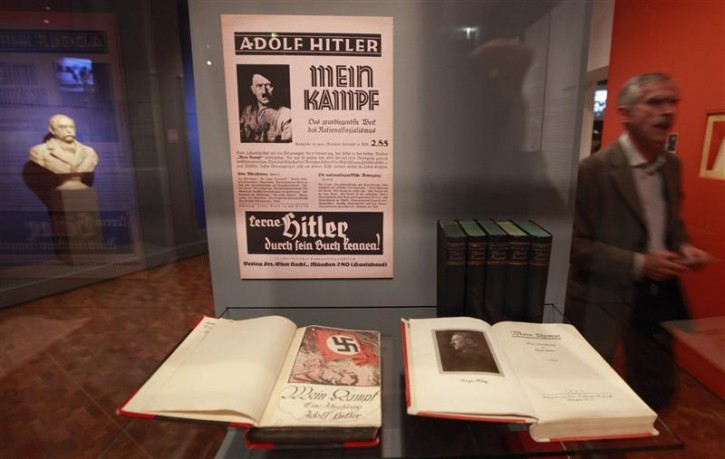 Berlin, Germany – Bronze Hitler busts of various sizes crown austere pedestals. A red paper lantern with a swastika floats in the air. A tiny toy model of the Fuehrer stands behind a swastika-bedecked lectern.
Berlin, Germany – Bronze Hitler busts of various sizes crown austere pedestals. A red paper lantern with a swastika floats in the air. A tiny toy model of the Fuehrer stands behind a swastika-bedecked lectern.
Subscribe to our Daily Roundup Email
This isn’t an auction of Nazi memorabilia but a major exhibition at a Berlin museum that delves into the personality cult that sprang up around Adolf Hitler — exploring with the help of period artifacts how he won mass support for his destructive regime.
The exhibition at the German Historical Museum that opened Thursday is the first exhibition in the German capital to focus so firmly on the Nazi dictator — another step in the erosion of German taboos concerning depictions of the Nazi era.
“Hitler and the Germans — Nation and Crime” comes more than 75 years after the Nazis took control, as Germans increasingly look at Hitler not as a one-dimensional monster, but as a complex figure who enjoyed vast popularity before plunging the country into war.
Such explorations of the Nazi past were inconceivable until not long ago, but in recent years there have been a series of films, exhibitions and plays that have shown Germany to be growing increasingly comfortable with confronting the phenomenon of Hitler’s rule directly — or even as the subject of satire or comedy.

Museum head Hans Ottomeyer acknowledged that, even now, “displaying Hitler is viewed as delicate.” He stressed that the show isn’t a “homage.”
“It is certainly not about Hitler as a person,” Ottomeyer said. “It tries to portray how Hitler grew out of the politics of his time, the mental state and fears, what methods he used and where that led, always in a dialogue of pictures and counter-pictures.”
Ottomeyer noted that Germany has had at least one previous exhibition on Hitler — “Hoffmann and Hitler,” a photo exhibition in Munich in the early 1990s that never made it to Berlin.
In recent years, Hitler has been the subject of a highly acclaimed German film portraying his final days, “Downfall,” and another portraying him as a comical idiot — “Mein Fuehrer: The Truly Truest Truth about Adolf Hitler.” He also has appeared as a waxwork at the Berlin branch of Madame Tussaud’s and is a regular subject of television documentaries.
The German Historical Museum has been considering the current exhibition since the early 2000s, but Ottomeyer said it decided against focusing more on the “bizarre personality” of Hitler in favor of a broader approach.
Curator Hans-Ulrich Thamer said he wanted to explore “how this power and influence, this domination of Adolf Hitler can be explained, and to make clear that one of the factors was the readiness to approve and the readiness to go along of large parts of society.”
The collection of some 600 exhibits, along with 400 photos and posters, takes visitors chronologically through the life of the regime. Nearly three-quarters of the material comes from the museum’s own extensive stores.
It portrays the Nazis’ dual approach of making the German masses feel included in their movement while excluding those whom they had identified as enemies, such as Jews, Gypsies, homosexuals and the disabled.
Items such as a case full of various Nazi organizations’ uniforms — placed opposite footage of the book-burning of tomes deemed “un-German” that was an emblematic moment in Hitler’s consolidation of power — and a Nazi rally flag underline the strategy of inclusion.

A tapestry produced in 1935 by Protestant and Catholic women puts the words of the Lord’s Prayer around a church with a swastika flag flying from its tower.
Nazi exclusion policies are is driven home by photos of Jewish deportations and of hospital patients being taken away for euthanasia — exhibited alongside an order signed by Hitler for the “incurably ill” to be granted “mercy death” — along with a note from a German company about equipment being supplied to the Auschwitz death camp.
Such exhibits help emphasize the fact that “the persecution of political opponents, the persecution of Jewish fellow citizens, the deportation of Jewish citizens took place in front of everyone’s eyes,” said Thamer, a history professor at the University of Muenster.
Thamer said he doesn’t expect the exhibition to generate controversy and isn’t worried that fringe far-right groups might try somehow to take advantage — again pointing to the balance carefully provided. He added that experience shows “such people don’t go to museums.”

The exhibition shows Hitler’s ubiquity in Nazi-era German life in everything down to playing cards with the dictator’s image, yet the curator steered clear of securing any personal belongings of the dictator. He argued that this would have little explanatory value and said he didn’t want to “support the peculiar fascination” that such items might exert.
The general secretary of Germany’s Central Council of Jews, Stephan Kramer, said he hadn’t yet seen the exhibition and couldn’t comment.
Pre-opening media coverage has been subdued. The exhibition includes dozens of editions of the weekly Der Spiegel with Hitler on the cover, starting in 1964.
Hitler didn’t make this week’s cover, however, and the magazine limited itself to a relatively brief story in which it remarked that the organizers appeared to be “afraid of their own courage” in leaving out, for example, monumental portraits of the dictator.
The show is open daily through Feb. 6.

but no, they dont admire him….